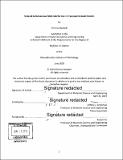Natural carbonaceous materials for use in transparent Joule heaters
Author(s)
Hasbach, Ximena.
Download1118687712-MIT.pdf (5.470Mb)
Other Contributors
Massachusetts Institute of Technology. Department of Materials Science and Engineering.
Advisor
Jeffrey C. Grossman.
Terms of use
Metadata
Show full item recordAbstract
Natural carbonaceous materials have the potential to be used in a new class of more economically and environmentally sound electronic devices due to their tunable conductivity as well as robust mechanical and thermal properties. This study aims to explore the potential of steam cracker tar (SCT), a byproduct of ethylene production, for use in conductive applications, specifically transparent Joule heaters. The SCT was made into thin films using both rod-rolling and spray-coating methods. After the superior uniformity of the rod-rolled films was observed, a 2 laser cutter was used to anneal the rod-rolled films with the intention of increasing their sp² content and thus improving their conductivity. First the power and then the z-defocusing of the laser were varied, and the ability of the resulting films to heat was tested with an applied voltage. To test the conductivity and heating capabilities of the annealed SCT films, 60 volts were applied, the current measured, and the number of degrees heated measured with a thermal camera software. A combination of Raman spectroscopy and profilometry was used to characterize the films. The film with the best heating capabilities was found to be the one annealed with 8% laser power and 0.2 inch z-defocus. This film was observed to heat to 35 degrees Celsius, and was demonstrated to efficiently de-ice a frozen sheet of tempered glass. Future work in this study will focus on finding ways to improve conductivity in SCT films with better transparency.
Description
Thesis: S.B., Massachusetts Institute of Technology, Department of Materials Science and Engineering, 2019 Cataloged from PDF version of thesis. Includes bibliographical references (page 35).
Date issued
2019Department
Massachusetts Institute of Technology. Department of Materials Science and EngineeringPublisher
Massachusetts Institute of Technology
Keywords
Materials Science and Engineering.